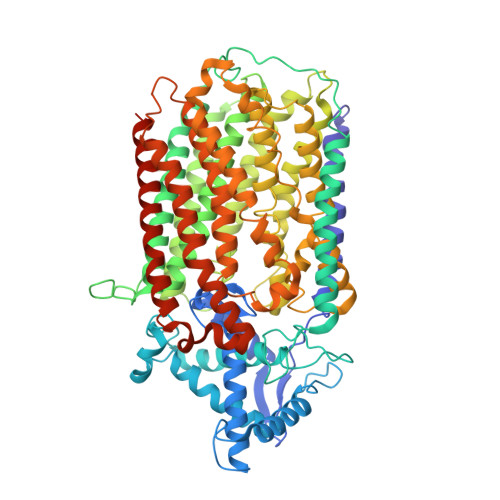The active form of quinol-dependent nitric oxide reductase fromNeisseria meningitidisis a dimer.
Jamali, M.A.M., Gopalasingam, C.C., Johnson, R.M., Tosha, T., Muramoto, K., Muench, S.P., Antonyuk, S.V., Shiro, Y., Hasnain, S.S.(2020) IUCrJ 7: 404-415
- PubMed: 32431824
- DOI: https://doi.org/10.1107/S2052252520003656
- Primary Citation of Related Structures:
6L1X, 6L3H, 6T6V - PubMed Abstract:
Neisseria meningitidis is carried by nearly a billion humans, causing developmental impairment and over 100 000 deaths a year. A quinol-dependent nitric oxide reductase (qNOR) plays a critical role in the survival of the bacterium in the human host. X-ray crystallographic analyses of qNOR, including that from N. meningitidis ( Nm qNOR) reported here at 3.15 Å resolution, show monomeric assemblies, despite the more active dimeric sample being used for crystallization. Cryo-electron microscopic analysis of the same chromatographic fraction of Nm qNOR, however, revealed a dimeric assembly at 3.06 Å resolution. It is shown that zinc (which is used in crystallization) binding near the dimer-stabilizing TMII region contributes to the disruption of the dimer. A similar destabilization is observed in the monomeric (∼85 kDa) cryo-EM structure of a mutant (Glu494Ala) qNOR from the opportunistic pathogen Alcaligenes ( Achromobacter ) xylosoxidans , which primarily migrates as a monomer. The monomer-dimer transition of qNORs seen in the cryo-EM and crystallographic structures has wider implications for structural studies of multimeric membrane proteins. X-ray crystallographic and cryo-EM structural analyses have been performed on the same chromatographic fraction of Nm qNOR to high resolution. This represents one of the first examples in which the two approaches have been used to reveal a monomeric assembly in crystallo and a dimeric assembly in vitrified cryo-EM grids. A number of factors have been identified that may trigger the destabilization of helices that are necessary to preserve the integrity of the dimer. These include zinc binding near the entry of the putative proton-transfer channel and the preservation of the conformational integrity of the active site. The mutation near the active site results in disruption of the active site, causing an additional destabilization of helices (TMIX and TMX) that flank the proton-transfer channel helices, creating an inert monomeric enzyme.
- Graduate School of Life Science, University of Hyogo, 3-2-1 Kouto, Kamigori, Ako, Hyogo 678-1297, Japan.
Organizational Affiliation:


















